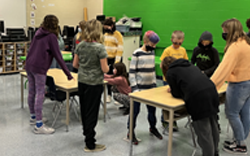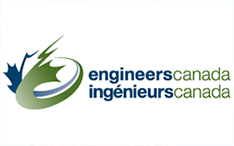President's message

In 2018, Engineers Canada embarked on a strategic planning process, characterized by an exceptional level of nation-wide collaboration, broad perspectives, and a focus on transparency. What resulted was a comprehensive strategic plan that has served as an important guide for our collective priorities and provided a framework for the last three years. Aimed at leading Engineers Canada in transformation to better serve regulators and promote and maintain the interests of the profession, the 2019-2021 strategic plan has helped Engineers Canada achieve significant progress. In the last three years, much of which has been like no other the world has experienced, I am particularly grateful for how Engineers Canada staff, volunteers, Board Directors, and our partners have responded given the constraints that a global pandemic have created. We saw a great deal of advancements over the past three years, culminating in us achieving our strategic plan objectives in 2021.
Over the past year, Engineers Canada’s 30 by 30 initiative to increase the number of newly licensed female-identifying engineers gained greater momentum. Our 2021 National Membership Report revealed that we reached 20.6% of newly licensed engineers identifying as female as of the end of 2020; 20 by 20, so to speak.
In addition, Engineers Canada has made it a top priority to evolve the accreditation system to ensure clarity and transparency for stakeholders. Activities undertaken in 2021 displayed the active efforts that have taken place over the last few years to achieve this, including the release of the first Accountability in Accreditation report – a collection of recommendations informed by feedback from accreditation stakeholders to enhance accreditation.
Engineers Canada also continued its work to provide services and tools that enable the assessment of engineering qualifications, foster excellence in engineering practice and regulation, and facilitate mobility of practitioners within Canada. The Competency-Based Assessment was fully operationalized and adopted by a number of regulators across the country. In addition, we launched the refined International Institutions and Degrees Database (IIDD), an upgraded tool to support regulators in assessing academic qualifications of international engineering graduates. These systems help regulators ensure that those seeking licensure are assessed fairly and consistently, regardless of where their qualifications are obtained.
Engineers Canada leads programs aimed at inspiring the next generation of talented and diverse engineers. In 2021, we launched the Future City Experience. The program, hosted virtually in 2021, is designed to introduce students to engineering in a fun and engaging way. We also launched the Engineers Canada Leadership Scholarship for undergraduate engineering students, while the 2021 National Engineering Month reached an audience of over two million people on social media, an 18 per cent increase from past years.
The Engineers Canada 2019-2021 Strategic Plan served as a pillar in our journey to advance Canadian engineering. Reflecting on the past few years, the world has changed significantly, and Engineers Canada has learned a great deal about ways to adapt to challenging situations and to improve our efforts going forward. As we conclude the final year of the plan, we are eagerly embarking on our 2022-2024 strategic plan. Woven throughout the new plan are areas where we will collaborate to strategically position our profession to address trends and risks, adapt to a changing regulatory landscape, select and adopt best practices, and remain relevant across Canada.
Sincerely,
Danny Chui, FEC, P.Eng.
President, Engineers Canada
Strategic priority 1: Accreditation Improvement Program

The Accreditation Improvement Program (AIP) is a coordinated effort to improve the delivery of accreditation for engineering programs and of the Enrolment and Degrees Awarded Survey. The program consists of four key elements, with the implementation of an improved data management system and continual improvement making notable advancements in 2021.
Recognizing the need to modernize how Engineers Canada collects and processes information as part of the accreditation process, we embarked on configuring Tandem, a web-based data management system. Since launching the first phase of the system in 2019 to support the collection of data for the Enrolment and Degrees Awarded Survey, Engineers Canada has made considerable progress in configuring the system for use in the accreditation process itself. The data management system continues to support data collection of the Enrolment and Degrees Awarded Survey, with improvements being made each year based on end-user feedback. As such, we anticipate implementing Tandem for accreditation in time for the 2023/2024 visit cycle.
As the full development of Tandem progresses, the project team is actively configuring the system to carry out the accreditation process. In 2021, the project team undertook multiple rounds of internal testing, developed an implementation plan, and continues to modify the system based on internal and external feedback.
In 2022, the project team has many activities expected to roll-out. This includes final configuration and internal end-to-end testing, data migration, the development of training materials, and planning for testing by external stakeholders. When it’s ready, Tandem will be the central information hub for managing a program’s accreditation process. From completing the Questionnaire to managing the visit team, Tandem is a singular platform for all aspects of the process, replacing the current Word and Excel documents.
In addition to our work related to Tandem, the Accreditation Improvement Program:
- Improved stakeholder communication and consultations by applying Engineers Canada’s five-step consultation process. In 2021, this process was applied to the Canadian Engineering Accreditation Board (CEAB) consultation on the Required Visit Materials Working Group Report and will inform the 2022 consultation on the CEAB Working Group to Respond to the Engineers Canada ’30 by 30’ Initiative report.
- Continued the distribution of Accreditation Matters, a monthly newsletter which continues to keep stakeholders informed on the AIP, Accreditation Board meeting outcomes, consultations, and relevant issues affecting accreditation.
- Provided a framework and methodology for developing training activities for individuals involved in the accreditation process. This methodology was applied throughout the summer of 2021 as the CEAB prepared nearly 100 volunteers and program representatives to undertake virtual accreditation visits. The training approach will be key to implementing Tandem for accreditation.
- Refined the continual improvement process to intake, analyze, prioritize, and follow-up on suggestions for improvement to accreditation and to the Enrolment and Degrees Awarded Survey (EDAS).
The communication, training, and continual improvement methodologies and tools have all been operationalized by Engineers Canada staff. Ongoing evaluation and improvement of these areas will persist beyond the strategic plan and will be applied to future initiatives, including the implementation of Tandem for accreditation.
Strategic priority 2: Accountability in Accreditation

The Accountability in Accreditation program is just one of Engineers Canada’s accreditation-related continual improvement processes. This particular program was named a strategic priority in the 2019-2021 strategic plan to ensure and measure the effectiveness, trustworthiness, transparency, and efficiency of the accreditation system.
As part of its Accountability in Accreditation Evaluation Strategy, the CEAB published its first Accountability in Accreditation report in 2021. The report is informed by feedback that was collected from regulators, general visitors, program visitors, visiting team chairs and vice-chairs, Engineers Canada Staff, deans, designated officials or program accreditation leads that received CEAB decisions in 2020 or hosted visits in the 2020/2021 accreditation cycle, as well as student leadership at Higher Education Institutions (HEIs) that were visited in 2020/2021. In its report, the Accountability in Accreditation Committee makes several recommendations to the CEAB, the Policies and Procedures Committee, and the CEAB Secretariat regarding communication and training needs, messaging for accreditation system stakeholders to clarify intents and purposes, and workflow and scheduling of CEAB products and processes. The CEAB’s Policies and Procedures Committee and CEAB Secretariat have evaluated the recommendations and have incorporated some recommendations into their 2022 workplans.
Data collection for the second measurement cycle is underway and the next Accountability in Accreditation report will be published in the Fall of 2022.
Strategic priority 3: Recruitment, Retention, and Professional Development of Women in the Profession

The journey to increase the representation of women in engineering through Strategic Priority 3 (SP3) continued to make progress in 2021. Engineers Canada deepened the analysis and understanding of gender equity in the profession, and continued to work collectively with the regulators and other engineering stakeholders to carry out the 30 by 30 initiative – a commitment to increasing the proportion of newly licensed engineers who are women to 30 per cent by 2030. In collaboration with the regulators, Engineers Canada has kept track of the number of newly licensed female-identifying engineers since 2014, as part of the 30 by 30 initiative. Data provided by the regulators in the 2021 National Membership Report, which covers the 2020 calendar year, indicates that the representation of female-identifying engineering members increased from 13.9 per cent in 2019, to 14.2 per cent in 2020. Although the number of female-identifying EITs decreased in 2020, the overall proportion increased slightly from 21.2 per cent in 2019 to 21.6 percent in 2020. Overall, female-identifying engineers accounted for 20.6 per cent of newly licensed engineers.
Gender Based Analysis Plus (GBA+) analysis
2021 marked a year of many firsts for the 30 by 30 initiative, including the release of a GBA+ analysis of national engineering licensure assistance and employer awareness programs. Engineers Canada hired a consultant to analyze the current national licensure assistance programming and employer awareness programming provided by the 12 provincial and territorial engineering regulators using a GBA+ lens, which is the Government of Canada’s analytical process for evaluating systemic inequalities in programs and initiatives. The report summarizes a number of challenges that underrepresented groups may face along their pathway to licensure, from being an undergraduate engineering student, to an engineer-in-training (EIT), to a newly licensed engineer. It also summarizes the challenges faced by demographic groups, including women, Indigenous persons, and foreign-trained engineers. The report gathered regulator perspectives on the 30 by 30 goal, and the ability to achieve 30 per cent female-identifying newly licensed engineers by 2030. Additionally, three recommendations are made for Engineers Canada in its efforts to achieve greater equity, diversity, and inclusion in the engineering profession. Regulator best practices were collected and shared as part of the development and publication of the GBA+ report on regulator EIT/MIT/engineering intern best practices, licensure assistance programs and employer awareness programs. In addition to the report, Engineers Canada’s CEO and staff met with each regulator to review the report findings and discuss specific challenges faced in each jurisdiction. A voluntary 30 by 30 scorecard was distributed to the regulators to support tracking of additional gender-based metrics.
30 by 30 Conference
In 2021, Engineers Canada hosted the very first 30 by 30 Conference: a multi-day virtual gathering of 30 by 30 Champions, engineering leaders, and engineers. The conference was an opportunity to actively engage with stakeholders and raise awareness of activities and research that focus on addressing the culture of exclusion against women and underrepresented groups (i.e. Black, Indigenous, people of colour, LGBTQ2+, persons with disabilities) in the profession. Consisting of four sessions held throughout the month of June, the final session was held on International Women in Engineering Day (INWED).
Stakeholder training
Engineers Canada completed the roll-out of equity, diversity, and inclusion training for the Board and CEOs in partnership with Catalyst, a global nonprofit which develops solutions, research, and training to improve gender equity and inclusion in the workplace.
As part of SP3, Engineers Canada produced content and hired a consultant to create an online equity, diversity and inclusion training module. The course was developed with guidance from the Equity, Diversity, and Inclusion Training Task Force, made up of representatives from the 30 by 30 Champions network, including engineering regulators, the National Society of Black Engineers (Canadian Chapters), Natural Sciences and Engineering Research Council (NSERC) Chairs for Women in Engineering, EngiQueers Canada, and in partnership with Engineers and Geoscientists British Columbia, and Geoscientists Canada.
This course is a foundational training on equity, diversity, and inclusion (EDI) to help individuals develop competencies in inclusive behaviours and emotional intelligence. It intends to empower all professionals to contribute to their full potential without barriers or discrimination. This includes people who are part of one or more equity-deserving groups that have been historically, persistently, and systemically marginalized in Canadian society, including but not limited to all genders, LGBTQ2S+ persons, Indigenous people, Black people, people of colour, and persons with disabilities. Through this course, engineers will gain knowledge and skills in cultural and emotional intelligence and other inclusive behaviours.
Engineers and Geoscientists British Columbia volunteered to host the course on their learning management system (LMS), which is scheduled to be launched in Q1 of 2022 and will be available to engineers across the country.
Stakeholder Engagement
In addition to facilitating stakeholder training sessions, Engineers Canada continued to engage stakeholders to advance the goals of SP3. This includes working with Engineering Deans Canada (EDC) to expand the 30 by 30 network to include all higher education institutions (HEIs). Currently, 65% of HEIs have appointed 30 by 30 Champions, including the 2021 addition of Thompson Rivers University. The year also comprised of quarterly meetings of the 30 by 30 working groups (i.e. K-12, Post-secondary, Early Career, Employer) and as well as sharing 30 by 30 network information and relevant research through the monthly distribution of the 30 by 30 newsletter.
Strategic priority 4: Competency-Based Assessment project

In partnership with Engineers and Geoscientists British Columbia, Engineers Canada’s support of the multi-year Competency-Based Assessment project yielded significant outcomes in 2021. After a four-year effort to make the online system available to engineering regulators across Canada, 2021 saw the completion of all major deliverables. The result is a fully operational pan-Canadian tool. The competency-based assessment tool has been adopted by six regulators, with four other regulators using the same competencies with a different tool.
The competency-based assessment is an online system for recording, assessing, and validating engineering work experience, and allows applicants to identify how they meet the competency standards set for professional engineering or geoscience registration. Translation of the tool is ongoing, and the French version is set to launch in April 2022. In addition, the translation of the Working in Canada seminar, a 50-hour plus virtual course that can be assigned to applicants who do not have sufficient Canadian work experience, has also been completely translated and will be made available to French applicants in April 2022.
Given the completion of the main deliverables (other than the finalization of the French translation work), Engineers Canada has fully closed the project and handed all ongoing operations to Engineers and Geoscientists British Columbia. All ongoing developments and considerations to the tool will be discussed at the regular National Admissions Officials group meeting moving forward.
Operational imperative 1: Accreditation

Engineers Canada has many responsibilities under its mandate, one of which is to accredit undergraduate engineering programs. As part of this responsibility, Engineers Canada remains committed to making continual improvements to the program to ensure its effectiveness and continued to carry out this commitment in 2021.
With ongoing COVID-19 restrictions, all accreditation visits took place virtually in both the 2020/2021 visit cycle (which included five new programs only, with all other scheduled visits being deferred by one year) and the 2021/2022 visit cycle (which included 17 visits to 79 programs). To prepare stakeholders for the virtual visit environment, the CEAB struck a Virtual Visit Working Group which produced the Guide to Virtual Evaluation of an Engineering Program, outlining the expectations for virtual visits. A training plan also was executed, offering virtual facilitation training for all visiting team chairs, webinars for Higher Education Institutions (HEIs) and visiting team members, and monthly virtual drop-in sessions for visiting team chairs to share their experiences and lessons learned.
The 2021/2022 virtual visit process was a significant pivot from our usual way of conducting and hosting accreditation visits requiring an enormous effort by 129 volunteers, 17 HEIs, and Engineers Canada staff to execute. The dedication of all involved to collaborate, innovate, and problem solve together in the face of a pandemic is a significant achievement in the history of our accreditation system. Planning for the 2022/2023 visit cycle is underway where 25 institutions will host in-person visiting teams across the country with contingency plans in place should health directives require a change in visit modality. Should this happen, the system will be ready to pivot once again.
In addition to its operational work to accredit undergraduate engineering programs, the CEAB made significant progress on a number of other items:
- Revised the definition of engineering design and interpretive statement to improve consistency of the application of accreditation criteria. This work included a 2020 consultation with external stakeholders, concluding in the Engineers Canada Board approving the definition and its application to accreditation criteria in October 2021. This change will be implemented in the 2023/2024 visit cycle.
- Amended the Interpretive Statement on Licensure Expectations and Requirements to provide more flexibility in curriculum and ensure the Interpretive Statement reflects modern pedagogical practices when counting Accreditation Units. This work was undertaken in partnership with Engineering Deans Canada’s Deans’ Liaison Committee and informed by feedback from the 2020 consultation. The revised Interpretive Statement was approved by the CEAB in June 2021 for implementation in the 2022/2023 visit cycle.
- Consulted on the Required Visit Materials Working Group Report which proposed changes to the materials that programs seeking accreditation submit to visiting teams for review. This work establishes a consistent set of required materials for CEAB visits based on best practices of audits while balancing the needs of CEAB visiting teams with the resource concerns expressed by HEIs. Maintaining the rigor of the accreditation system expected by the regulators was central in this work. The revised requirements were approved by the CEAB at their September 2021 meeting for implementation in the 2023/2024 visit cycle.
- The pandemic has necessitated the CEAB to look at the utility of the Accreditation Units (AU) as curriculum content measurement. The AU relies on ‘contact time’ between the student and faculty. The pandemic has shifted the educational delivery methods and as a result, the concept of ‘contact time’ is difficult to reconcile and the AU may not be the best input measurement tool. The Policies and Procedures Committee began its work on examining the issue in 2021 and work will continue into 2022.
Operational imperative 2: Regulator relationships

Maintaining strong, healthy relationships with regulators is one of Engineers Canada’s top priorities; and facilitating effective connections between regulators is of equal importance. A fundamental component of Engineers Canada’s work is national collaboration. This involves the exchange of information and ideas and active participation of regulators on various programs and projects. To sustain this, we continued to create spaces and opportunities for regulators to build working relationships, collaborate, and share resources.
To facilitate discussions around Engineers Canada’s different areas of focus, Engineers Canada organizes and encourages meetings for regulator representatives through various groups. In 2021, regulators remained active and collaborative throughout the year in groups for admissions officials, discipline & enforcement officials, and practice officials as well as at the leadership level with meetings of the CEO Group and the Presidents Group. They also participated in small working groups to support the development of the Competency-Based Assessment, International Institutions and Degrees Database, and National Membership Database projects. Additionally, regulators participated on the K-12 Career Awareness Working Group as well as the Post-Secondary and Early Career Professional. Through these working groups regulators coordinated their outreach and engagement efforts for shared target audiences and in the development of educational resources. Finally, Engineers Canada also hosted the annual Regulator Presentation at the Annual General Meeting. This session provides an opportunity for each president to highlight the achievements, challenges and lessons learned from their regulator in the past year.
Operational imperative 3: Services and tools
Canadian Engineering Qualifications Board

Through the Canadian Engineering Qualifications Board (CEQB) Engineers Canada develops and maintains work products that serve the needs of regulators and of practising engineers. This includes guidelines for regulators and the public, Engineers Canada papers, and examination syllabi. These resources enable the assessment of engineering qualifications, foster excellence in engineering practice and regulation, and facilitate mobility of practitioners in Canada.
In keeping with previous years, 2021 saw the review, revision, and creation of a variety of resources by the CEQB. By the end of 2021:
- Syllabi for computer engineering and software engineering were approved.
- Syllabi on aeronautical and aerospace engineering and metallurgical/materials engineering were prepared for consideration by CEQB in January 2022.
- Syllabi on agricultural/bioresource engineering and complementary studies were progressing.
- Work on the new guidelines on diversity and inclusion, and indigenous consultation, the national feasibility study, and the revised paper on software engineering all made significant progress.
National Membership Database
The development of the new National Membership Database (NMDB) is underway and system requirements were finalized with regulators in 2021. The system underwent a privacy impact assessment and vulnerability penetration testing in 2021 and passed both with minimal updates required. Due to delays in the contracting phase, development is expected to be completed in April 2022 with full launch by June 2022. When completed, the refreshed system will improve the functionality of the database, strengthen data security, and improve the quality of the information in the system. The database is one of the tools regulators use to facilitate mobility within Canada.
Operational imperative 4: National Programs

Engineers Canada offers a number of programs that are intended to benefit regulators and engineers. This is done through sponsored initiatives and partnerships, also known as affinity programs.
At the beginning of 2021, we launched the third iteration of the social media awareness campaign for the Secondary Professional Liability Insurance Program (SPLIP). The program saw much success in increasing traffic to the SPLIP pages of the Engineers Canada website. Based on prior learnings, Facebook and LinkedIn were incorporated in the fall campaign roll-out.
Hub International, in collaboration with Engineers Canada completed a market exercise for the SPLIP. The exercise resulted in coverage enhancements and a rate reduction guaranteed for a three-year term (March 31, 2021-March 31, 2024) with AXA XL.
Geoscientists Nova Scotia joined the Engineers Canada sponsored home and auto insurance program. In addition, clients in the TD Insurance home and auto program will benefit from an increase in the number of TD Insurance Auto Centres, now totalling 22 Canada-wide. These centres are the only one-stop shops in Canada where clients can speak to a claims advisor, get their car repaired, and get a rental car.
With the support of TD Insurance, Engineers Canada launched the #EngineeringLife series in our newsletter, Engineering Matters. This occasional series explores the human side of engineering through stories and insights in the lives of engineers. This initiative is part of an integrated strategy to promote our partnership and the TD Insurance home and auto programs. The series garnered close to five million impressions on social media, while the related promotion of the TD Insurance home and auto programs received more than five million impressions as a result of the campaign.
In collaboration with Manulife, Engineers Canada secured a loyalty bonus for clients enrolled in the Engineers Canada sponsored term life program. This bonus comes in the form of premium refunds, which are applied as a credit and which result in a reduction in premiums for one year. Manulife and Engineers Canada continued to provide access to a Health Care Online App (Akira by Telus Health) for the health and dental program insureds. Services include specialist referrals, lab test requisitions, diagnosis of health concerns, and prescriptions. The continuation of this service is to help insured members during the pandemic.
Engineers Canada signed a 3-year agreement with the Avis Budget Group for its car rental program, renegotiated with no increase in rental rates.
Finally, in consultation with Aon, our benefits consultant, and discussions with the participating regulators in the national employee group benefits program, Engineers Canada directed Manulife to implement a rate reduction to the Health and Dental Care benefits, as well as continuing to provide Health Care Online (Akira by Telus health). This was possible using monies from the Program’s Unrestricted Deposit Account.
Operational imperative 5: Advocating to the federal government

Engineers Canada provides evidence-based views on matters of public policy that affect the engineering regulators and the profession, and influences government policy- and decision-making on issues of interest to the profession. Engineers Canada’s public affairs and government relations work ensures that engineers are involved in the creation of public policy, and that engineering expertise is used in drafting and reviewing public policy.
Engineers Canada uses National Position Statements to outline the public policy priorities of the engineering profession in our conversations with government. These statements provide evidence-based perspectives on matters of public policy that affect the engineering profession.
In 2021, the Public Affairs and Government Relations team updated all National Position Statements to reflect the most up-to-date information available. Three new National Position Statements were also developed and approved by the Engineers Canada Board:
- The role of engineers in Canada’s long-term economic recovery
- Building Canada’s high-speed broadband through a sustainable digital infrastructure
- Professional practice in biotechnology
In addition, we updated five existing National Position Statements relating to:
- Research, development and innovation
- Immigration and foreign qualifications recognition
- Qualifications to provide engineering expertise to panels and boards under federal jurisdiction
- Qualified Person vs Professional Engineer
- Science, Technology, Engineering and Mathematics (STEM) Education
Issue Statements are meant to quickly respond to government actions or emerging issues that affect the engineering regulators or the engineering profession. In 2021, the Public Affairs and Government Relations team developed two new Issue Statements in response to issues affecting the engineering profession:
- Engineers’ role in Canada’s long-term economic recovery post-COVID-19
- Air quality and building management: Reducing the airborne transmission of the COVID-19 virus
Government submissions
Engineers Canada’s government relations team actively advocates for the engineering regulators and the engineering profession in front of the federal government on a range of issues that affect the engineering profession and its regulation. In 2021, Engineers Canada secured several opportunities to engage and provide written briefs to the federal government through multiple submissions that included:
- Submission to the House of Commons Standing Committee on Human Resources, Skills and Social Development and the Status of Persons with Disabilities on the Review of the Employment Insurance program
- Engineers Canada Federal Budget 2021 Highlights and Analysis
- Engineers Canada’s submission to the House of Commons Standing Committee on Finance in Advance of the 2022 Budget
- Engineers Canada’s comments to Natural Resources Canada regarding the People-Centred Just Transition Discussion Paper
- Engineers Canada's Comments to Environment and Climate Change Canada regarding three offshore exploration drilling projects off the coast of Newfoundland and Labrador
- Engineers Canada’s comments on a possible Canada-Indonesia Comprehensive Economic Partnership Agreement (CEPA)
- Engineers Canada’s comments to Global Affairs Canada on the free trade agreement negotiations with the United Kingdom and its possible accession to the Comprehensive and Progressive Agreement for Trans-Pacific Partnership (CPTPP)
- Engineers Canada’s Comments to Natural Resources Canada’s discussion paper regarding Canada’s Approach to Offshore Renewable Energy Regulations.
- Engineers Canada’s comments on Canada’s National Infrastructure Assessment: “Building the Canada We Want in 2050”
Engineers Canada also held numerous meetings with elected officials and senior public servants to discuss issues relating to the engineering regulators and to the engineering profession.
Operational imperative 6: Monitoring, researching, and advising

One of Engineers Canada’s core purposes on behalf of the engineering regulators is to proactively identify, investigate, and explain trends and changes that are likely to have an impact on regulation and the future of the engineering profession. A key part of this work is communicating research findings to regulators on an ongoing basis, to support their own decision-making and direction-setting processes.
To this end, in 2021 we published multiple articles covering topics such as environmental, social, and governance (ESG) reporting in engineering, licensure examinations during COVID-19, the role of volunteers in self-regulation, engineering and the United Nations Sustainable Development Goals, big data in regulation, foreign credential recognition, regulators’ role in building equity, diversity and inclusion, and changes and oversight in regulatory frameworks.
We also published papers about entity regulation and non-practising status – two topics that regulators had requested we examine in order to support their own transitions, improvements and decision-making in these areas.
Finally, 2021 also saw the release of a paper on the emerging engineering practice of Autonomous Systems engineering. This paper explains the practice of engineering relating to autonomous systems; it provides information and guidance for regulators to identify autonomous engineering; and ways for consideration on how to regulate effectively in conjunction with existing tools.
Operational imperative 7: International mobility

As the national body representing the engineering regulators, Engineers Canada is well positioned to define the risks and opportunities associated with the mobility of work and practitioners internationally. By recommending actions to the regulators that manage and respond to these impacts, Engineers Canada helps inform regulatory decisions around this area in each jurisdiction.
International Institutions and Degrees Database
Engineers Canada launched an upgraded tool to help engineering regulators assess the academic qualification of international engineering graduates. The International Institutions and Degrees Database (IIDD) provides up-to-date information about engineering programs from over 140 countries around the world. It includes background about a country’s education system, the legitimacy of specific institutions and degrees, and whether a degree meets academic requirements for professional licensure in that country. The IIDD was launched in 2009, upgraded in 2014 and again in 2021. In this year’s upgrade, the IIDD was expanded to provide more information to regulators about institutions and degrees, including information about quality assurance systems and the link between education and the licensing/registration system in each country, where applicable.
Engineerhere.ca
Becoming familiar with the licensure process to become an engineer in Canada can be challenging, especially for those seeking information from outside of Canada. In response to this need, Engineers Canada created the webpage engineerhere.ca in 2019. To support the global audience of engineerhere.ca, licensure information in a variety of languages was added in 2021. These pages provide core information about the licensure process in 11 different languages: Arabic, Bengali, Chinese (Traditional), Chinese (Simplified), English, Farsi, French, Hindi, Spanish, Tagalog, and Urdu.
International Engineering Alliance
Engineers Canada participated at the virtual meetings of the International Engineering Alliance (IEA). The meetings included reviews of new applicants to include in the agreements and accords, as well as reviews of existing signatories and members. Our International Mobility Advisory Group, comprised of a group of regulators, attended these meetings for the first time. This was a first step in evaluating IEA processes and providing recommendations to all regulators on use of the IEA agreements and accords as well as our level of engagement or leadership within the IEA.
APEC and IPEA Reviews
At a special January 2021 meeting of the International Engineering Alliance, our report to respond to the concerns of the review team looking at our international mobility register was accepted as demonstrating substantial equivalence with the international competency standard. As a result, we remain members of the Asia Pacific Economic Cooperation (APEC) Engineers Agreement and International Professional Engineers Agreement (IPEA) for another six years from the date of our original review.
Washington Accord
As part of our ongoing obligations as a Washington Accord signatory, we received a monitoring visit in November. Washington Accord signatories are subject to such a review at least every six years to maintain their signatory status. The objective of the monitoring review is to demonstrate that our accreditation system remains substantially equivalent to other Washington Accord signatories. As part of this process, we wrote a self-study report and hosted an international review team drawn from the United Kingdom, Turkey, and Japan who observed virtual CEAB accreditation visits to two institutions in November. The monitoring review team will also observe the June 2022 CEAB decision meeting. Similar to Engineers Canada’s accreditation system, the Washington Accord review was impacted by pandemic-related travel restrictions and the review team meeting was hosted in a virtual format – a first for the Washington Accord system. Additionally, one of the two institutions whose accreditation visits were observed by the Washington Accord review team is a French-speaking institution requiring us to arrange virtual simultaneous interpretation for the non-French speaking review team. We are grateful to the institutions who granted permission for the review team to observe their visit, to the CEAB visiting teams who welcomed the review team as part of their own, and to the review team themselves who showed great flexibility and collaboration in planning and executing these milestone visits.
The monitoring team’s findings and subsequent recommendation on our signatory status will be presented to other signatories in 2022.
Operational imperative 8: Promotion and outreach

Girl Guide Crest Program
The Engineering crest was created by Engineers Canada, in partnership with Girl Guides Canada, to be awarded to guides who complete engineering-related activities under the supervision of a member of the engineering community such as a professional engineer, engineer-in-training, engineering graduate, or engineering student. Throughout the year, 3,010 crests were distributed to Girl Guides across Canada. Due to the continued success of the program and after consultation with Engineers Canada’s K-12 Career Awareness Working group, the decision was made to expand this program to include Scouts Canada. Work to expand the program to include Scouts will commence in 2022.
Future City Program
New in 2021, Engineers Canada launched the Future City Experience, an abbreviated version of the Future City Competition intended for educators and students who are new to Future City. The Future City Experience was designed to introduce students to engineering in the same fun and engaging way as the Future City Competition, but without the commitment of the full competition and with additional support from engineer mentors. The new version was entirely virtual and could be adapted to in-class or online learning models. Similar to the Future City Competition, it asked students in grades 6, 7, and 8 to use the engineering design process to imagine, research, design, and build cities 100 years into the future. The theme for Future City 2021 was Living on the Moon and asked students to design a futuristic lunar city.
National Engineering Month
National Engineering Month (NEM), Canada’s largest celebration of engineering, kicked off virtually for another year in 2021. The month-long celebration spotlighted a different theme each week, encouraging engineering students, professionals, companies, and associations to take to social media (#NEM2021) and demonstrate their pride in the engineering profession and their work related to that week’s theme. NEM 2021 saw 6,710 participants participate in the nation-wide initiatives. The social media campaign saw similar achievements, reaching over 2,765,130 users, an 18% increase from previous years.
Engineers Canada Awards
The Engineers Canada Awards recognize and celebrate the achievements of engineers and engineering students who are advancing the engineering profession and improving the lives of Canadians and others around the world. In replacement of the annual Awards Gala due to the impacts of COVID-19, Engineers Canada launched a social media campaign on Twitter, Facebook, and LinkedIn to showcase the work of award recipients. Recipients in 2021 were:
- Samuel Pierre, PhD, FCAE, ing. – Gold Medal Award
- Leslie Russell, PhD, FEC, P.Eng. - Meritorious Service Award for Professional Service Award
- Claire Kennedy, FRCGS, P.Eng. - Meritorious Service Award for Community Service
- William Cluett, PhD, P.Eng. - Medal for Distinction in Engineering Education
- Catherine Mavriplis, PhD, FCAE, P.Eng. - Award for the Support of Women in the Engineering Profession
- Matthew Tutty - Gold Medal Student Award
Learn more about our 2021 award recipients.
Engineers Canada Scholarships
The implementation of approved recommendations from the scholarship program review was completed, including the launch of a leadership scholarship for undergraduate engineering students. Similar to the awards program, scholarship recipients were celebrated through a series of promotional campaigns and a series of social media posts across Engineers Canada’s social media platforms. The recipients of the 2021 scholarships were:
Engineers Canada-TD Insurance Scholarships ($7,500)
- Danielle Maitland, MASc, MSc, P.Eng.
- Jeffrey Underhill, FEC, P.Eng.
- Keenan Ngo, P.Eng.
Engineers Canada–Manulife Scholarships ($12,500)
- Colin Dreger, M.Eng., P.Eng.
- Sheida Stephens, P.Eng.
- Tia Shapka-Fels, P.Eng.
Engineers Canada Leadership Scholarship ($4,000)
- Coralie Tcheune
- Dalena Vo
- Daniel Wood
- Kimberly Watada
- Masooma Tahir
- Sydney Wheatley
- Yazan Zamel
- Yudi Yang
Learn more about our 2021 scholarship recipients.
Fellows of Engineers Canada
Professional Engineers of Ontario
Rod Young, P.Eng.
Ken Slack, P.Eng.
Engineers Nova Scotia
Crysta Cumming, P.Eng.
Christian Boudreau, P.Eng.
Dennis Fowler, P.Eng.
Peter Murray, P.Eng.
Rob Jamieson, P.Eng.
Association of Professional Engineers and Geoscientists
Sebastian P. Walrond, P.Eng.
Robert Cochran, P.Eng.
Catherine Griffith, P.Eng.
Jessica Theriault, P.Eng
Ondiveerapan Thirunavukkarasu, P.Eng.
E. Kwei Quaye, P.Eng.
Ordre des ingénieurs du Québec (OIQ)
Samuel Pierre, ing.
Nicolas Turgeon, ing.
Engineers and Geoscientists BC
Dr. Rehan Sadiq
Ghassem Zarbi, P.Eng.
George Allan Barclay, P.Eng.
Vernon Lawrence Buchholz, P.Eng. (Retired)
Anthony Michael Horlor, P.Eng.
Robert Verne Hadden, P.Eng.
Maria Ewelina Holuszko, P.Eng.
Darryl John Hansen, P.Eng.
Inna Michalowski, P.Eng.
Dharam Pall Kajal, P.Eng.
Raymond Wai-Ming Chin, P.Eng.
Armando Abello, P.Eng.
David Yat-Fai Chan, P.Eng.
Albert Wing Kin Chow, P.Eng.
Dale William Goudie, P.Eng.
Fridrich Lederer, P.Eng. (Non-Practising)
Garry Wayne Stevenson, P.Eng./P.Geo., FGC
Kenneth Wayne Newbert, P.Eng.
Gregory Irving Smith, P.Eng., Struct.Eng.
Mubashir Husain Siddiqui, P.Eng.
Anthony Ka-Pong Lau, P.Eng.
Micheal John O'Keeffe, P.Eng., Struct.Eng.
Lane Ronald John Logan, P.Eng.
Joseph Hayward Rousseau, P.Eng.
Derek Ken Sakamoto, P.Eng.
Thomas Fitzgerald Luc Whalen, P.Eng.
Weiguo Zhan, P.Eng. (Non-Practising)
Bernard Edmond Laval, P.Eng.
Gerald Charles O'Hara, P.Eng. (Retired)
Scott William Campbell, P.Eng.
Mark Tamer Alev, P.Eng.
Shi Ping Wu, P.Eng.
Gholam-Hossein Yavari, P.Eng.
Kemal Ozgur, P.Eng.
Wing-Wo Henry Wong, P.Eng.
Piotr Pawel Mazur, P.Eng.
Shamsul Alam Chowdhury, P.Eng.
Tomas Mojica, P.Eng.
Gregory Howard Martin Hatton, P.Eng.
Amr M. Fathalla, P.Eng.
Dieter Diedericks, P.Eng.
Thomas Camillo Stubens, P.Eng.
Scott Alexander Loptson, P.Eng.
Charles Joseph Michael Harrison, P.Eng.
Pulak Mukerjee, P.Eng. (Retired)
Jose M. Torrecampo III, P.Eng.
Jian Guo Chen, P.Eng.
Saqib Ahmed Khan, P.Eng.
Marius Mihai Ciornei, P.Eng.
Mohammadreza Jarollahi, P.Eng.
Xiaoqi Fang, P.Eng.
Lee David Rowley, P.Eng.
Reto Nicolao Corfu, P.Eng.
Denver Maharaj, P.Eng.
Jarrod Reed Koster, P.Eng.
Tarek Abbas Abdel-Sattar El-Amoury, P.Eng., Struct.Eng.
Stephen Karrer O'Leary, P.Eng.
Larry Bruce Spence, P.Eng.
Mihai G. D. Georgescu, P.Eng.
Wesley Gregg Narciso
Melissa May Heidema
Joseph Fritz Fernandez
Maya Charnell
Sze Tak Chiu
Ron McOuat
Craig Daniel Work
Neil Cumming
Brent Burton
Keith Alexander Recsky
Phillip Chow
Engineers and Geoscientists Manitoba
Nicholas Douville, P.Eng.
Hanns Till Freihammer, P.Eng.
Brian McIntosh, P.Eng.
Jeffrey Rempel, P.Eng.
James Watling, P.Eng.
Neil Klassen (not an engineer – FEC (Hon) recipient)
Engineers PEI
Wendy Weeks, P.Eng.
APEGA
Samer Adeeb, P.Eng.
Margaret Allen, P.Eng., P.GEO.
George Anderson, P.Eng.
Johnathan Assels, P.Eng.
John Doucette, P.Eng.
Sandeep Gupta, P.Eng.
Ralph Hildenbrant, P.Eng.
Tom Johnston, P.Eng.
Zoltan Koles, P.Eng.
Alan Newcombe, P.Eng.
Joel Nodelman, P.Eng.
Paul Ryzuk, P.Eng.
Spencer Torrie, P.Eng.
Claudia Villeneuve, P.Eng.
Professional Engineers Ontario
Mir Haris Ahmadzai, P.Eng.
Tarun Biju, P.Eng.
Shiva Bissoon, P.Eng.
Darla Campbell, P.Eng.
Kevin Hughes, P.Eng.
Samer Inchasi, P.Eng.
Chistopher Tyler Ing, P.Eng.
Andrew Lawton, P.Eng.
Norbert Lee, P.Eng.
Gajananda Mailvaganam, P.Eng.
Jeffrey Neilson, P.Eng.
Iretomiwa Olukiyesi, P.Eng.
Stephen Quinlan, P.Eng.
Saif Rehman, P.Eng.
Shailesshkumar Shah, P.Eng.
Abdul Shaikh, P.Eng.
David Uren, P.Eng.
David Uren, P.Eng.
Nicholas Vlachopoulos, P.Eng.
Lija Ward, P.Eng.
Zachary White, P.Eng
William Cluett, P.Eng.
Claire Kennedy, P.Eng.
Catherine Mavriplis, P.Eng.
National Outreach Working Group
Engineers Canada’s Digital Engagement and Online Campaign Working Groups were combined to create the National Outreach Working Group. The group has created sub-working groups to focus on three key target audiences: K-12 students, post-secondary students, and engineers-in-training and early career professionals. All the engagement initiatives and activities that were developed through this group, specifically the Digital Scavenger Hunt (K to grade 6), Design Challenges (grades 6 to 8) and online game (grades 9 to 12) are live on our ExploreEngineering.ca website.
Operational imperative 9: Diversity and Inclusion

Diversity and inclusion are key enablers of progression in the engineering profession. Engineers Canada continued working to foster a collaborative profession, drive innovation, develop programs and resources, and guide business practices to establish and sustain equity, diversity and inclusion in engineering. Our areas of focus are primarily on increasing the recruitment, retention, and professional development of women and reducing barriers for Indigenous people to enter and thrive in the engineering profession. In 2021, we worked towards reconciliation through research, analysis, training, and stakeholder engagement.
Reconciliation in Engineering
In partnership with Engineers and Geoscientists British Columbia, Engineers Canada hosted a webinar on exploring the practice of acknowledging First Peoples and traditional land as a way to open meetings and also as part of a larger process towards reconciliation between non-Indigenous and Indigenous Peoples in Canada, with a panel of Indigenous engineers and geoscientists. In collaboration with the Indigenous Advisory Committee, Engineers Canada also updated the Land Acknowledgement Guide to lead our staff, volunteers, community members, and others in creating meaningful land acknowledgements in their day-to-day practices.
To undertake research and analysis of the experiences of Indigenous engineers and improve the reporting of Indigenous engineers and engineering students, we worked with Big River Analytics on two reports. Big River Analytics undertook a study to estimate Indigenous representation in the engineering workforce, and found that Indigenous people are underrepresented in engineering occupations, relative to Indigenous representation in the total population and in the labour force. Big River Analytics has also completed a pilot survey of Indigenous engineers with three regulators. This report is expected to be published in early 2022.
Engineers Canada also partnered with University of British Columbia researchers to conduct interviews with Indigenous students and engineers within HEIs on their experiences and insights on truth and reconciliation in engineering education. Findings of this research will be available in early 2022.
To further advance reconciliation, and ensure foundational knowledge of Indigenous peoples, histories, and communities remain accessible, the 4 Seasons for Reconciliation training was offered to the Engineers Canada Board, CEAB, CEQB, regulator CEOs and presidents, and Engineering Deans Canada. We are also pleased to see several regulators enter into agreements with the provider to offer further training to their stakeholders.
Throughout 2021, Engineers Canada continued to consult with our Indigenous Advisory Committee (IAC) on building relationships with Indigenous organizations and engineers. The IAC recommended that Engineers Canada become a member of the Canadian Council of Aboriginal Business (CCAB) and to apply for the CCAB’s Progressing Aboriginal Relations certification, a process which will be undertaken throughout 2022.
Operational imperative 10: Protecting official marks
On behalf of the provincial engineering regulators, Engineers Canada holds and administers a portfolio of intellectual properties that include official marks and registered trademarks, including registered certification marks.
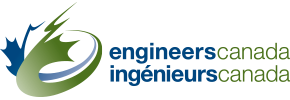
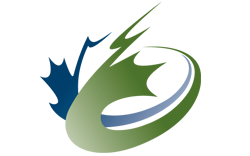

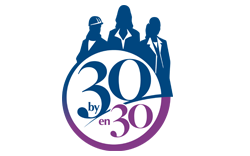
In 2021, as with previous years, we provided a presentation to the members of the National Discipline and Enforcement Officials group, providing insight into the trademark application process and Engineers Canada’s strategy and approach to managing its opposition proceedings. In keeping with previous years, in 2021, we continued to review and evaluate Engineers Canada’s trademark enforcement strategy to ensure trademarks and official marks continue to be adequately used and protected.
Engineers Canada is the owner of an official mark for each of the following professional engineering designations:
- ENGINEER
- ENGINEERING
- CONSULTING ENGINEER
- PROFESSIONAL ENGINEER
- P.ENG.
- GÉNIE
- INGÉNIERIE
- INGÉNIEUR CONSEIL
- INGÉNIEUR
- ING.
Governance

Under the 2019-2021 Strategic Plan, and according to Board policy, there are six Board responsibilities, each of which was met in 2021 with the support of Engineers Canada staff. The policy states that the Board shall:
- Hold itself, its directors, and its direct reports accountable
- Sustain a process to engage with regulators through regular communication that facilitates input, evaluation, and feedback
- Provide ongoing and appropriate strategic direction
- Ensure the development and periodic review of Board policies
- Ensure the CEO maintains and acts on a robust and effective risk management system which reflects the Board’s risk tolerance level and directs Board-approved mitigation strategies
- Provide orientation of new directors, and continuing development of directors and others who work closely with the Board
In meeting these responsibilities, the Board: approved revisions to forty policies and adopted two new policies and a new guideline; conducted the governance effectiveness survey and implemented the resulting recommendations and actions; approved the 2020 recommendations for CEO evaluation and the 2021 CEO objectives; secured a consultant to conduct the informal evaluation of the CEO’s performance; and monitored performance against the Strategic Plan through interim reporting, among other things.
Financial Statements












